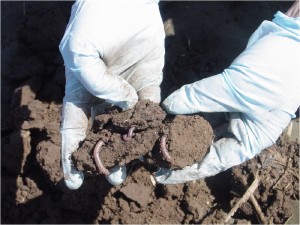Biosolids, Animal Manure, and Earthworms: Is There a Connection?
 Scientist collected earthworms from a soybean field fertilized with biosolids. The earthworms were analyzed for 77 different chemicals; 20 chemicals were detected in the earthworms.
Scientist collected earthworms from a soybean field fertilized with biosolids. The earthworms were analyzed for 77 different chemicals; 20 chemicals were detected in the earthworms.
(Click on photo for larger version) |
|
Animal manure and biosolids, the solid byproduct of wastewater treatment, often are applied to agricultural crops to provide nutrients for plant growth and to improve the quality of soil. Earthworms studied in agricultural fields where manure and biosolids were applied have been found to contain organic chemicals from household products and manure. Earthworms continuously ingest soils and may accumulate any soil contaminants into their bodies. The chemicals detected included the active ingredients commonly found in a variety of household products—including the disinfectant found in antibacterial soaps, fragrances used in perfumes and detergents, and pharmaceuticals. The chemicals targeted in this study are referred to collectively by the authors as anthropogenic waste indicators (AWIs – see side bar).
U.S. Geological Survey scientists and their colleague from Colorado State University at Pueblo published the results of the earthworm study in Environmental Science and Technology. The scientists collected soil and earthworms from three agricultural fields—a soybean field fertilized with biosolids, a corn field fertilized with swine manure, and a soybean field that had received no applications of either biosolids or manure for at least 7 years. Samples were collected approximately one month after manure and biosolid applications (in the early part of the growing season) and again just before harvest. To determine what was in the material being applied to these fields, the scientists also collected samples of the applied biosolids and swine manure. All samples were analyzed for 77 AWIs. They found:
-
|
Anthropogenic Waste Indicators
Anthropogenic waste indicators (AWIs) are organic chemicals that are found in waste sources such as biosolids or wastewater effluent from wastewater treatment plants (WWTPs). AWIs are made up of a wide variety of organic chemicals, some of which are found in household products such as prescription drugs, over-the-counter drugs, detergents, antibacterial soaps, fragrances, and pesticides. Some AWIs are naturally occurring chemicals (such as plant and animal sterols) that are concentrated by the treatment processes at WWTPs.
Biosolids
Biosolids are created from the sludge generated by the treatment of sewage at WWTPs. WWTPs in the United States generate approximately 8 million dry tons of biosolids each year. Since biosolids are rich in plant nutrients, about 50 percent of the annual production of biosolids in the United States is applied to fields and gardens as fertilizer for plants. Biosolids must meet standards set by the U.S. Environmental Protection Agency for nutrient, metal, and pathogen content before it can be used to fertilize plants and to improve the quality of soil. Biosolids have relatively higher concentrations of organic wastewater contaminants than their liquid counterparts—effluent discharged from wastewater treatment plants.
More Information
References
Kinney, C.A., Furlong, E.T., Zaugg, S.D., Burkhardt, M.R., Werner, S.L., Cahill, J.D., and Jorgensen, G.R., 2006, Survey of organic wastewater contaminants in biosolids destined for land application: Environmental Science and Technology, v. 40, no. 23, p. 7207-7215, doi:10.1021/es0603406.
Glassmeyer, S.T., Furlong, E.T., Kolpin, D.W., Cahill, J.D., Zaugg, S.D., Werner, S.L., Meyer, M.T., and Kryak, D.D., 2005, Transport of chemical and microbial compounds from known wastewater dishcarges--Potential for use as indicators of human fecal contamination: Environmental Science and Technology, v. 39, no. 14, p. 5157-5169, doi:10.1021/es048120k.
|
|
Twenty-five of the 28 AWIs detected in the biosolids applied to a soybean field were also found in the earthworms from the field.
- Twenty-one AWIs were detected in the earthworms from the field where swine manure was applied; however, concentrations of contaminants were dominated by natural plant and animal sterol compounds.
- Several compounds were detected in earthworms collected both from the biosolids- and manure-applied fields, including phenol (disinfectant), tributylphosphate (antifoaming agent and flame retardant), benzophenone (fixative, binds fragrances in soaps and other products), trimethoprim (antibiotic), and the synthetic fragrances galaxolide and tonalide.
- Detergent metabolites and the disinfectant triclosan were found in earthworms from the biosolids-applied field, but not the manure-applied field.
- Somewhat surprisingly, earthworms from the control field (no recent application of biosolids or manure) contained detections of some of the same compounds, indicating potential persistence in the environment or another source.
- A few of the chemicals that were detected in the earthworms were not detected in the corresponding soil samples.
These results build upon two recent studies that found that household chemicals were detected in biosolids and that pharmaceuticals were found in soil irrigated with reclaimed water.
This study is part of a long-term effort by the U.S. Geological Survey’s Toxic Substances Hydrology Program to determine the fates and effects of pharmaceuticals and other emerging contaminants in aquatic and terrestrial environments, and to provide water-resource managers with objective information that assists in the development of optimal wastewater management practices.
Reference
Kinney, C.A., Furlong, E.T., Kolpin, D.W., Burkhardt, M.R., Zaugg, S.D., Werner, S.L., Bossio, J.P., and Benotti, M.J., 2008, Bioaccumulation of pharmaceuticals and other anthropogenic waste indicators in earthworms from agricultural soil amended with biosolid or swine manure: Environmental Science and Technology, doi:10.1021/es702304c (Advanced Web release).
More Information
Related Headlines
Back to Headlines page
|

|